Excerpts from Jim Conrad's
Naturalist Newsletter
from the July 14, 2013 Newsletter issued from the Frio Canyon Nature Education Center in the valley of the Dry Frio River in northern Uvalde County, southwestern Texas, on the southern border of the Edwards Plateau; elevation ~1750m (~5750 ft); N29.62°, W99.86°; USA
BROWNFOOT
A thigh-high wildflower member of the Composite or Sunflower Family heavily laden with panicles of pinkish-white flower heads leaned against a fence along the road, as shown below:
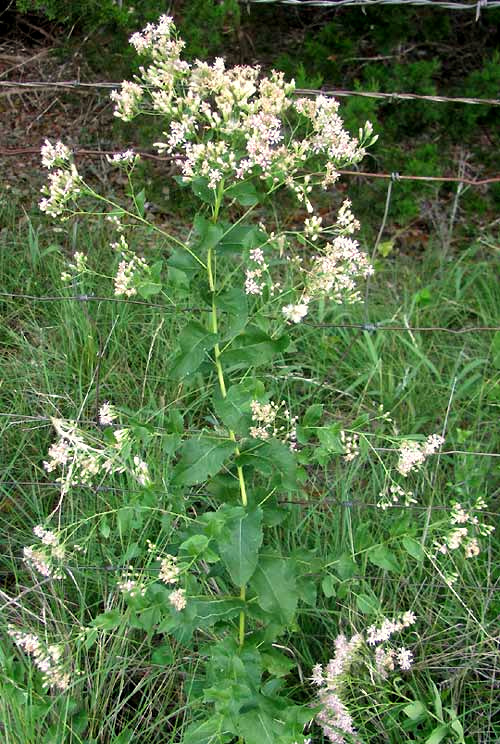
It looked like a member of the big genus Eupatorium, whose members commonly are called bonesets, thoroughworts, snakeroots or just eupatorium, and which are very common in the humid East. In fact, I almost ignored the fence plant because here in the Dry Frio Valley already I've seen so many new-to-me Composite Family members that I can't keep them all straight.
However, this was the first eupatorium-type wildflower I've seen here, so maybe it would turn out to be something special. I turned the bike around and settled down next to the plant to "do the botany." The first field mark noted was that the blossoms, unlike most eupatoriums, were pleasingly fragrant.
A side view of the flowering heads shows that the calyx-like involucre consists of overlapping, scale-like bracts, or phyllaries, like the eupatoriums, but textured differently from other eupatorium phyllaries I've seen, as shown below:
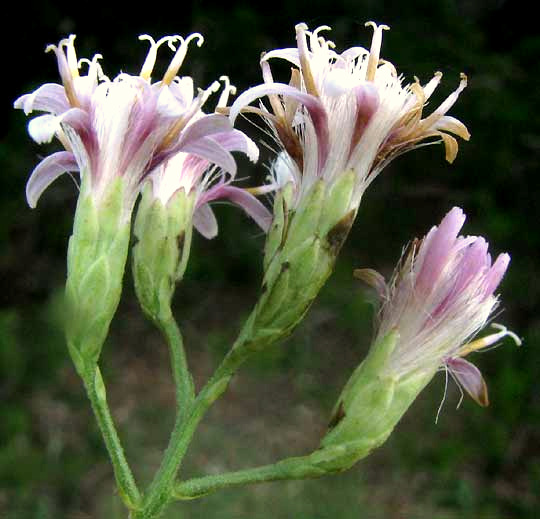
Eupatorium flower heads don't produce petal-like ray flowers; they're composed only of cylindrical disk flowers, the ones commonly forming "eyes" in most composite flowering heads. Well, some of our fence-plant's flowering heads almost look as if they have ray flowers. In the above picture, do you see those flat side-flowers curving away from the sides the way ray flowers might? This confused me, so a closer look was taken of an individual flower, shown below:
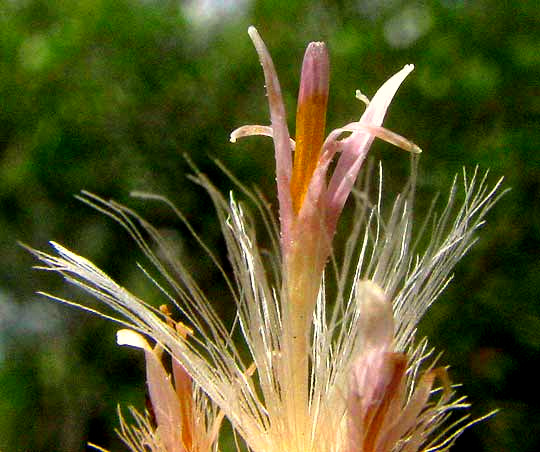
The vertical, orange structure in the picture's center consists of the flower's five long, slender, pollen-producing anthers fused along their edges to form a cylinder around the style. That's perfectly normal for the Composites, but what isn't normal is that the five corolla lobes are of different widths. There's a wide one and the rest are much more slender, meaning that the flower is not radially symmetrical, but rather bilaterally symmetrical, which is somewhat unusual for the Composite Family. More importantly, such blatantly bilaterally symmetrical flowers are not allowed in the Eupatorium "tribe" -- a subdivision of the Composite Family -- the Eupatorieae. Our fence plant is not a Eupatorium, and it isn't even closely related to it.
So, we have something unexpected here, so attention had to be paid to other field marks for later identification. Certain flowering heads already were fruiting. Below, you can see some heads with their parachuted, cypsela-type fruits about to launch into the wind:
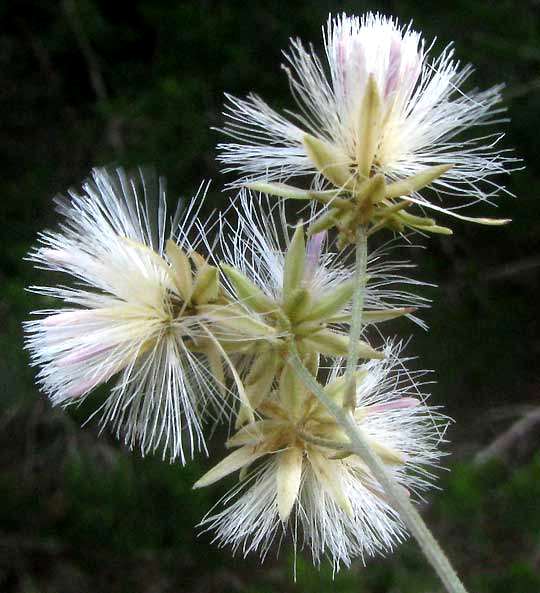
Most of the fence plant's stem leaves arose one per node -- they were "alternate." Their blades were attached directly to the stem in such a way that parts of the blade passed beyond the stem to form "ears," or basal lobes, as shown below:
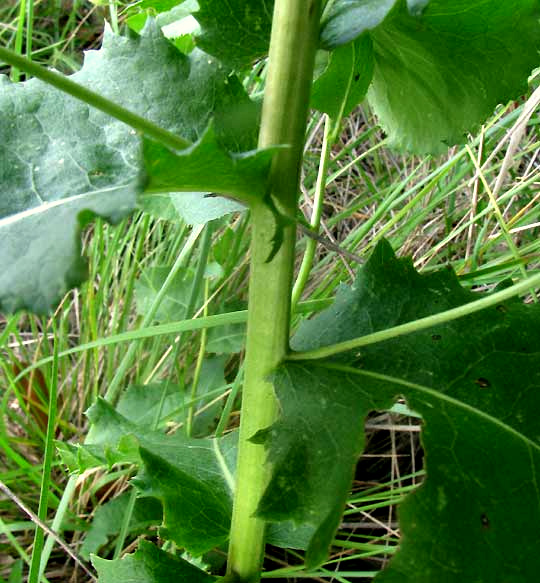
Composite Family genera producing bilaterally symmetrical flowers are so relatively uncommon that our fence plant fairly quickly keyed out to this: ACOURTIA WRIGHTII, known in wildflower books as Brownfoot, and described by the Flora of North America as living on gravel, caliche, or sandy, loamy soils in open desert in much of northern Mexico, and in the US in Arizona, New Mexico, Utah and Texas. Our environment is a little lusher than "open desert," but we're on the eastern border of Brownfoot's distribution, so non-standard behavior can be excused.
The genus Acourtia embraces about 41 species in warm regions of Mexico, Central America and the southwestern US, with five species in the US. This is our second Acourtia species found here. The other, Acourtia runcinata, is more common. Though the flowers of our two Acourtia species are very similar, their body types differ radically. You've seen that Brownfoot produces a substantial branched stem. Our earlier Acourtia produced no stem at all, as you can confirm at http://www.backyardnature.net/n/h/acourtia.htm.
The Peterson Field Guide to Western Medicinal Plants and Herbs reports that Brownfoot's root has been used by the Navajo as a tea for women giving birth, to ease difficult labors and as a postpartum remedy.
from the December 15, 2013 Newsletter issued from the Frio Canyon Nature Education Center in the valley of the Dry Frio River in northern Uvalde County, southwestern Texas, on the southern border of the Edwards Plateau; elevation ~1750m (~5750 ft); N29.62°, W99.86°; USA
BROWNFOOT AT FROST TIME
Now after hard freezes have converted our grasslands to dun-colored oceans, suddenly Brownfoot has become conspicuous. You see a little island of greenness amidst all the frost-killed brownness, and the greenness is topped with dazzling white fuzz, as shown below:
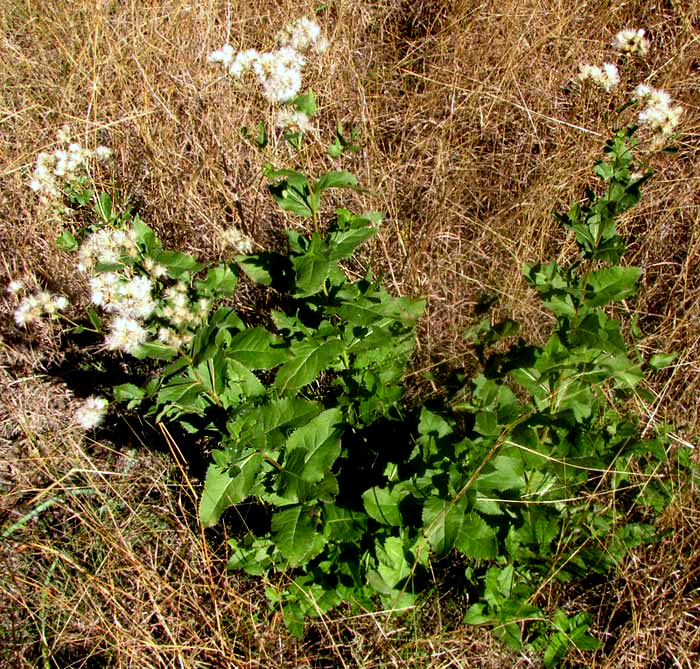
The white fuzz is clusters of white-parachuted fruits. And who knows how and why the plant stays so green after our freezes?